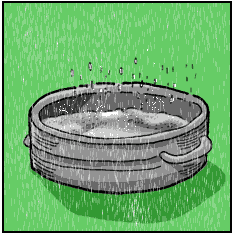
Measure a Raindrop
[15 Minutes]
Raindrops, which are made of millions and millions of tiny drops of water, vary in size from 1/100 of an inch to 1/4 of an inch. The smallest raindrops sometimes take an hour to fall to the ground. This type of precipitation is called drizzle. These raindrops fall from clouds that are about 1.2 miles deep. The heaviest raindrops, which sometimes form as hail, fall from clouds that can be 9 miles deep.
You'll need:
• flour, enough to cover the bottom of a pan • a flat pan • strainer or sieve • paper (optional) • pencil (optional)
What to do:
- If possible, print out these directions. Read them though together, before you begin.
- Together, gather everything you'll need and always remember science safety.
- With your child, cover the bottom of a flat pan with flour.
- Let her set the pan outside in the rain for just a few minutes. She should quickly bring the pan inside.
- Have her strain or sift the flour.
- Observe what happens.
- You and your child may wish to measure the different size lumps.
- To make comparisons, try this experiment when it is drizzling, raining heavily, or even hailing.
Useful information:
The raindrops will cause lumps in the flour (the bigger the lumps, the larger the raindrops. The water molecules bond tightly together as they hit the pan. The flour lightly coats the bonded molecules of water and increases their visibility.
|